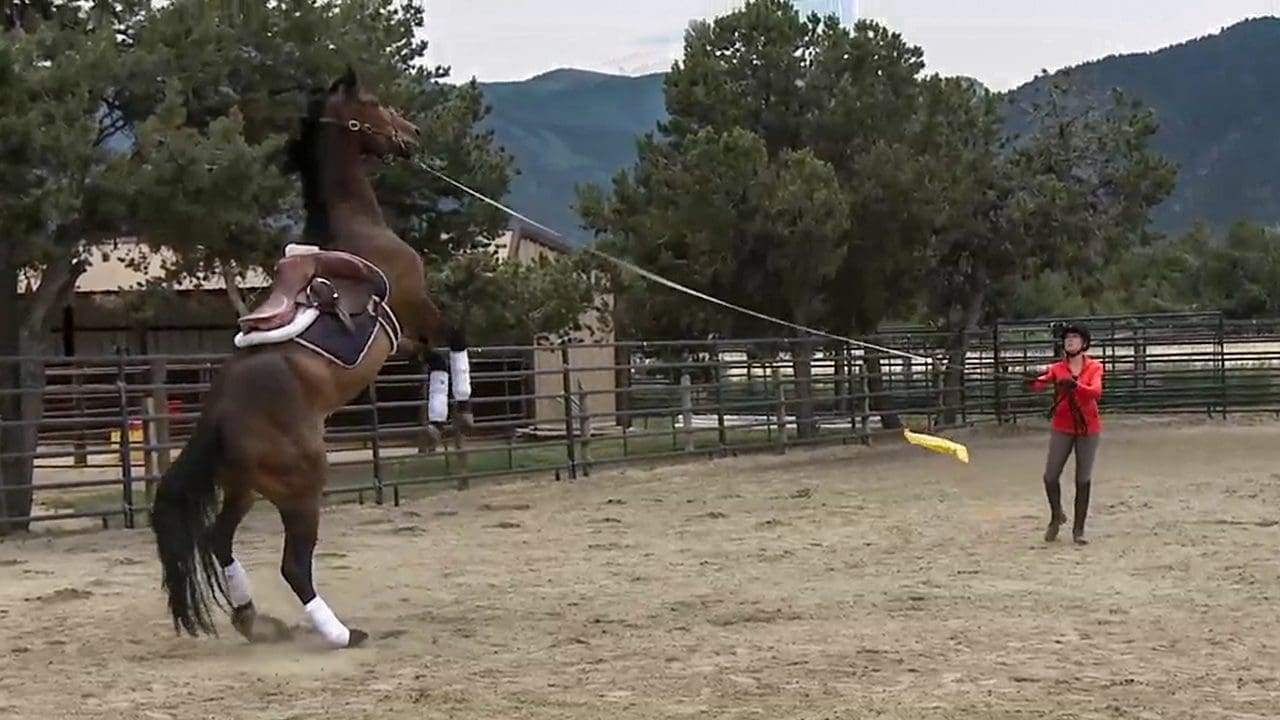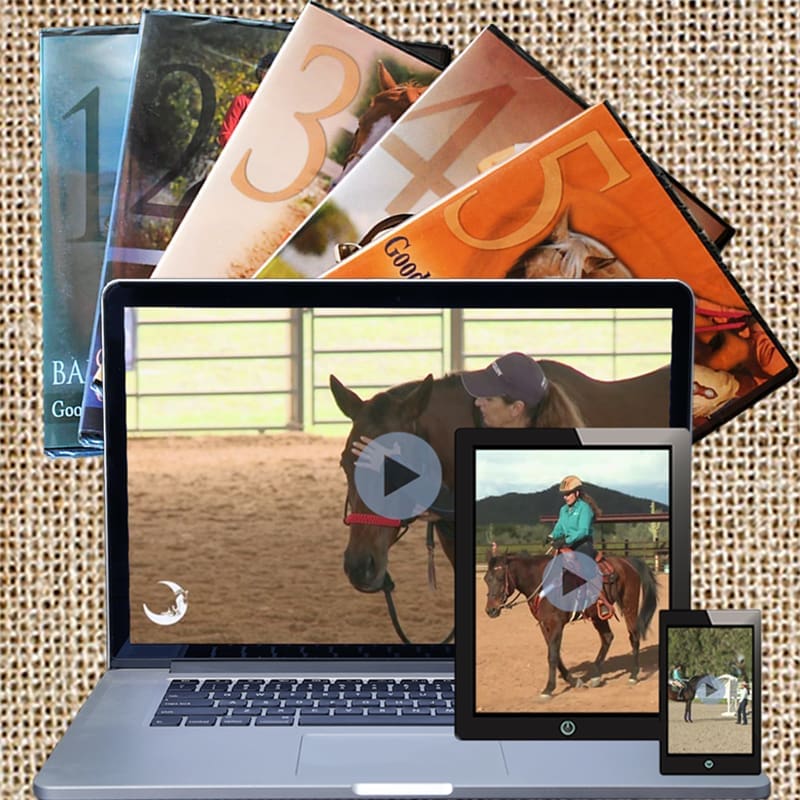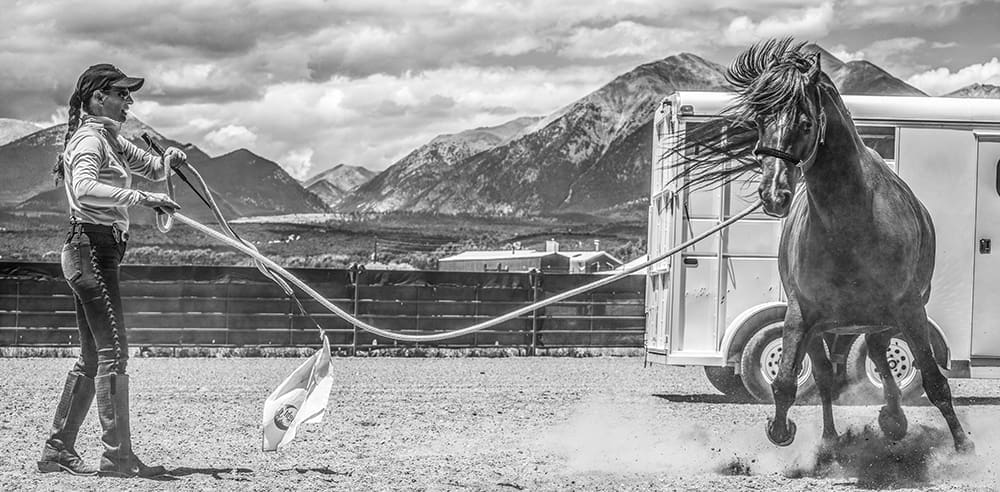
One of the most memorable episodes of Horse Master for me involved a lovely warmblood mare who developed a rearing problem after a successful run as a show jumper. The sweet and kind mare stood straight up as I mounted her—before I even sat down. Although sometimes rearing can become a learned response or a training problem, in this otherwise obedient and compliant horse, all the clues pointed toward pain as the cause.
Rearing occurs when the horse stands straight up on its hind legs. This behavior is often rooted in fear, but can also be a result of pain. In some instances, rearing or rear-threats may indicate a refusal to move forward, or it can occur when forward movement is inhibited.
Whether you are on the ground or in the saddle, it is one of the scariest and most dangerous behaviors of horses. Hopefully you will never have to deal with a rearing horse, but if you do, a little bit of knowledge may help you avoid some of the most common mistakes—and help keep you and your horse safe.
When it comes to rearing, it is important to fully understand the nature of this behavior and what to do when it happens. Here, I’ll discuss what causes rearing, how to avoid it, what to do if it happens, and how to keep safe when this scary and dangerous behavior is displayed.
Naturally “Light on the Forehand”
Some horses are more prone to rearing than others. In some ways, you can think of it as an expression or mannerism. While some horses are more prone to kick out, strike or shake their heads when they are feeling angst, others will tend to rear. Often, horses will threaten to rear—lifting the head and hopping up on the front feet—but never actually rear.
It is not always possible to know if the behavior a horse is displaying in the moment is instinctive or learned; this is the age-old debate of nature Vs. nurture. Rearing can easily become a learned response to get out of something the horse does not want to do, however, some horses clearly favor this behavior over others as an expression.
Regardless of whether it is a natural tendency in the horse, a learned response, or the result of a specific situation, proper handling and training will alleviate the behavior and help keep all four feet on the ground.
Root Causes
Even though some horses may have a natural tendency toward this behavior, all horses are capable of rearing, given the right circumstance. As with any undesirable behavior we are trying to eliminate, avoid, or train out of the horse, it helps to understand the root cause.
Pain, or fear of pain, is one of the most common root causes of many undesirable behaviors in horses. When a horse that has a history of performing well, suddenly does not, it is often a pain response. It may be the rider’s first indication of a developing physical problem, just as it was with the warm-blood mare.
It is quite common in high performance horses—jumpers, reiners, cowhorses, rope horses, barrel racers, or any horses that are training and competing in these athletically demanding sports, to suddenly refuse to participate. Often, rearing is the only way the horse has to tell you it cannot cope with the pain.
If rearing occurs when you ask a horse to perform a certain maneuver or task, particularly when it is an otherwise compliant and obedient horse, it is likely a result of pain. If this is the case, no amount of training will resolve the behavior until the pain is treated. Unless there is specific evidence that it is a learned disobedient response, not rooted in pain, the horse should be thoroughly vetted for a physical problem before any training plan is instigated.
Often, instinctive behaviors become learned behaviors with horses. They are wicked-fast learners and sometimes a horse can learn that a certain response got him what he wanted, even though initially it was an instinctive response. Perhaps the horse reared the first time due to a pain response when you asked him to perform a difficult task and in an abundance of caution, you stopped riding immediately to check the horse out.
Even though the incident was caused by pain, and even once you resolve the pain, you may still see the rearing behavior. It is possible for the horse to make an association between his rearing and you putting him away, on the very first incident. Still, you must always resolve the physical issue first, and with certainty, then come back and address the training problem once the pain is resolved.
Fear and Refusal
Rearing can easily be classified as a fear response, whether it is based in pain (the horse fears that when he does a certain movement it will hurt) or simply when the horse refuses to do something or becomes disobedient. Oddly, there are two seemingly opposite scenarios that commonly provoke rearing—a refusal to move forward or when forward motion is inhibited.
Let’s say you are asking the horse to cross running water with steep banks and creepy overhanging vegetation, and the horse is afraid for his safety and plants his feet in refusal. If you continue to push the horse forward and he is determined not to go, he may rear (or threaten to rear) in protest. Other common scenarios that provoke rearing are loading into a trailer or leaving the barnyard alone—both a refusal to move forward.
The other scenario that often provokes rearing is when forward motion is inhibited in a horse that is determined to go. Maybe you are on a trail ride with a group of horses and they take off at a fast pace while you try to hold your horse back, inhibiting its forward motion. This often provokes rearing in the horse, based on his strong instinctive fear of being left behind.
Whether rearing is the result of a refusal to move forward or when forward motion is inhibited, it is often based in fear initially. Unfortunately, the horse can easily learn to rear as a tactic to get out of something he does not want to do. It is important to take the time to alleviate the horse’s fear in a systematic way to avoid rearing if possible and once a horse does rear, to make sure he does not associate rearing with a means to avoid work.
Rearing Vs Rear Threats
A horse that rears suddenly will often stand straight up on his hind legs, in a nearly vertical position. However, a horse that is thinking about rearing and who is building up to a mutiny, may display rear threats by popping up with its front feet, just a few inches off the ground, as it throws its head up. This is a communicative gesture that means the horse is considering rearing if you keep pushing.
If a rear threat gets the horse any advantage, perceived or real, he will certainly employ the tactic again. Rear threats may or may not lead to full rearing; you do not get to know in advance. But if you are prepared to safely and confidently deal with a full-blown rear, you may want to push through the threats, insisting the horse move quietly forward, turning one way then the other.
When a horse threatens to rear and it causes the rider to ditch her plan (and cave on the directive she gave to the horse), the horse may learn that its threats have value. Sometimes this can become a favored tactic of the horse whenever it does not want to comply, holding the rider hostage to its threats. If you think you are in this situation already with a horse, you probably need the help of a trainer, or a more experienced horse person, to learn how to break this cycle.
As with all threatening behavior from horses, whether it is threatening to kick or buck or charge, when a horse threatens to rear, it could be a bluff. Many horses will learn that rear threats get them what they want, even though they may never actually rear. However, just like when people become threatening, you must take threats seriously because your safety is at stake.
Solutions to Rearing
No matter what the cause, when a horse rears, the solution is always the same– to move the horse immediately forward in whatever means is available to you, in whatever direction it will go. It is not possible for the horse to simultaneously rear and move forward. Forward motion is the antidote to rearing.
It always helps if you understand why the horse is displaying unwanted behavior. In the case of rearing, sometimes it is obvious, like the horse that refuses to leave the barn or cross water or get in a trailer; or the horse being held back while the other horses take off; or the trail horse that senses a rattlesnake ahead. In these cases, the rearing behavior may be avoided entirely or addressed through training and desensitization.
If the reason the horse is rearing is not immediately obvious, chances are good it is related to pain or fear of pain (it hurt once before). Often rearing that presents as a training problem actually stems from pain. The horse should have a thorough veterinary assessment and lameness exam before any further riding or training.
Once a physical cause is ruled out, the horse’s training can be addressed. If the cause of the rearing was indeed pain, even once fully healed, the horse may still rear, either because it has a fear-based memory of the pain or because the horse learned a new tactic to avoid work. These causes are often very difficult to distinguish and you may need the help of a professional to navigate through the horse’s behavior.
If pain is not the cause, the next most likely reason for the horse to rear is fear. Instinctive fear-based behaviors like not separating from the herd or not entering dark, closed-in spaces, or places where predators might lurk, require deliberate training to overcome. Over time we gain more control and trust from the horse, slowly building its confidence, never scaring, or endangering the horse.
In the case of a horse that is rearing in a flat-out refusal to comply with the rider’s commands, even if the reason seems obvious, a physical cause should always be considered first—it’s common for rearing to present as disobedience. But sometimes horses can learn clever tactics to manipulate riders into doing what they want (or don’t want to do), pushing boundaries on riders that lack confidence. Again, a trainer or riding instructor can generally help riders navigate through the disobedience and show more leadership to the horse.
If a horse is rearing because you are inhibiting its forward motion, holding it back when the other horses take off, the solution is simple—just let the horse move forward then worry about controlling that forward motion. Holding back a panicked horse as the rest of the herd rides away is a case of diminishing returns. Avoid that situation entirely by going with the herd or not riding with people that like to go fast. Determine what skills you need as a rider and what skills you need to train to the horse if you need to overcome this kind of rearing.

Goodnight's Principles of Riding Training Videos
Position, balance, rhythm & cueing
Exercises to improve riding skills
Cantering—everything from how to ride the canter to flying lead changes.
For the more advanced rider, advanced use of the aids, collection & lateral movements
Why Rearing is Dangerous
The number one danger when a horse rears, is the potential for the horse to lose its balance, either because its feet slip, or the rider or handler pulls on the horse at precisely the wrong time, causing it to lose balance. If the horse falls over backwards, it can easily strike its poll, causing a fatal head injury, break its withers, or crush the person that gets pinned underneath. This is why it is considered one of the most dangerous behaviors of horses.
Horses that are prone to rearing are dangerous and should only be ridden by competent riders who know how to safely manage a horse that rears and a training plan should be developed to give the horse the remedial training it needs. But you may encounter rearing with no warning and suddenly find yourself in a hazardous situation. There are a few critical actions that will keep you safer in this scary situation.
When handling a horse from the ground, never pull on the lead rope of a rearing horse. When a horse rears up, pressure on its poll will make it worse, as it leans into the pressure. Since the horse uses its head and neck for balance, interference from the lead rope can make it fall. When a horse you are handling from the ground rears, hang onto the rope, but give the horse slack. Back away to keep out of the way of its flailing front hooves.
When riding a horse that rears, riders instinctively do the wrong thing, pulling back on the reins, either in fear or because of loss of balance. But just like with the horse from the ground, pulling on the reins is likely to make the horse lose balance and fall.
If a horse I am riding rears, I instantly grab around the neck to hold on and throw my weight forward and, to prevent me from pulling on reins. Keeping a rein in each hand, I hug around the horse’s neck as he ascends, and slip my feet out of the stirrups, in case the horse falls. Once it comes back down, I will send it forward immediately, in any direction I can.
Keep in mind that balking (planting all four feet and not moving) often precedes rearing. When a horse freezes up, sometimes rearing or explosive movement follows. Use your directional aids to rock the horse side-to-side, right to left to right movement, to slowly re-establish forward motion.
All in a Day’s Work
There are times and situations in which any horse would rear, and if dealt with properly and safely, the undesirable behavior goes away. It is only when a horse develops a habit of rearing, or benefits from rearing, or loses their instinctive fear of falling over that rearing becomes a critical problem in the horse’s training.
Rearing can be as dangerous to people as it is to horses and a horse with a history of rearing should only be handled and ridden by the most competent and experienced personnel, who know how to avoid the behavior and deal with it when it happens. Mistakes can be deadly and people often instinctively do the wrong thing when a horse rears. Yet when a rider has the knowledge, experience, and tools to employ, rearing can be easily managed and resolved. Always recognize that rearing is a warning sign of problems– either physical, mental, or training wise. Find the root cause and develop a plan to address the deficiencies.
Remember that lovely warm-blood mare in Horse Master? Turned out she did have an injury in her back that could be resolved with chiropractic treatment, rest, and rehab. Once cleared for riding, her owner brought her to my ranch so I could help her ease back into it. You can see that first post-injury ride I took on her at the end of the episode. That mare never missed a step, had no lingering issues, and went on to become a successful show jumper once again. Just goes to show you that sometimes all horses need is our help.



